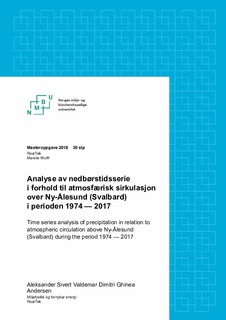| dc.contributor.advisor | Wolff, Mareile Astrid | |
| dc.contributor.advisor | Isaksen, Ketil | |
| dc.contributor.advisor | Grimenes, Arne Auen | |
| dc.contributor.author | Andersen, Aleksander Sivert Valdemar Dimitri Ghinea | |
| dc.coverage.spatial | Norway, Svalbard, Ny-Ålesund | nb_NO |
| dc.date.accessioned | 2018-11-05T10:09:22Z | |
| dc.date.available | 2018-11-05T10:09:22Z | |
| dc.date.issued | 2018 | |
| dc.identifier.uri | http://hdl.handle.net/11250/2570937 | |
| dc.description.abstract | In the Arctic, the temperature increase has been more than double of the global increase. The archipelago of Svalbard is among the regions in the Arctic where the observed climate change is at its biggest. Future climate simulations predict a continued warming and increase of precipitation in the Arctic. In this master thesis a precipitation time series from Ny-Ålesund (Svalbard) was analysed. It was studied how the precipitation data related to classified weather types above Spitsbergen (Svalbard). Data was included from the periods 1974 – 2000 and 2001 – 2017. Overall, a net increase in precipitation amounts was found in Ny-Ålesund. Most of the increase in precipitation amounts has happened during autumn and winter, primarily during the months of January (33 %), September (18 %) and October (12 %). Eight weather types explain most of the changes in the precipitation totals. These weather types occur 32 % of the days each year, and they explain 77 % of the change in the precipitation totals. Changes in air mass characteristics have driven most of this increase. This applies to most of the months with the exception of November and December. On the contrary, changes in frequency of different weather types explain little of the observed increases in precipitation. The only exception is the month of December. Further, it was found that extreme precipitation events explain 82 % of the change in precipitation amounts. Orographic effects caused by nearby mountains seem to play a vital role. The mountains have especially an effect on the air masses from southwestern and southern directions. A reasonable cause for the increase in the precipitation amounts seem to be an increase of the ambient temperature which have augmented the amount of water vapour in the air from local and remote locations in the ocean, and thus serving as sources for precipitable water in the atmosphere. | nb_NO |
| dc.description.abstract | Oppvarmingen i Arktis har vært over det dobbelte av den globale. Øygruppen Svalbard er blant de områdene i Arktis hvor de observerte klimaendringene er størst. Ifølge klimaframskrivninger beregnes det fortsatt økning i temperatur og nedbør i Arktis. Denne masteroppgaven har analysert en nedbørstidsserie fra Ny-Ålesund (Svalbard). Nedbørstidsserien er analysert sammen med klassifiserte værtyper over Spitsbergen. Analysen har tatt for seg periodene 1974 – 2000 og 2001 – 2017. Målet med oppgaven har vært å finne ut om og eventuelt hvordan nedbørsendringer i Ny-Ålesund kan knyttes til forandringer i hyppighet av værtyper og egenskaper til luftmasser over Spitsbergen (Svalbard). Det ble funnet at en vesentlig del av økningen i nedbør i Ny-Ålesund har skjedd om høsten og vinteren, først og fremst i månedene januar (33 %), september (18 %) og oktober (12 %). Åtte værtyper står bak det meste av nedbørsendringen. Disse værtypene forekommer 32 % av dagene i året, og har medført 77 % av den årlige nedbørsendringen. Endringer i luftmassenes egenskaper, har bidratt til mesteparten av økningen. Dette gjelder for de fleste måneder unntatt november og desember. Til sammenligning kan nedbørsøkningen som følge av forandringer i hyppigheten til de forskjellige værtypene, mesteparten av nedbørsendringene kun i desember. Videre ble det funnet ut at ekstreme daglige nedbørshendelser står bak 82 % av nedbørsendringen. Orografiske effekter fra nærliggende fjell synes å spille en viktig rolle. Fjellene påvirker spesielt luftmasser som kommer fra sørvestlig og sørlig retning. Økningen i nedbør kommer trolig som følge av økt lufttemperatur som har bidratt til høyere fuktighetsinnhold i luftmassene, sammen med større transport av vanndamp fra fordampning lokalt og i havet lengre unna, i kildeområdene for nedbøren. | nb_NO |
| dc.language.iso | nob | nb_NO |
| dc.publisher | Norwegian University of Life Sciences, Ås | nb_NO |
| dc.rights | Attribution-NonCommercial-NoDerivatives 4.0 Internasjonal | * |
| dc.rights.uri | http://creativecommons.org/licenses/by-nc-nd/4.0/deed.no | * |
| dc.subject | Ny-Ålesund | nb_NO |
| dc.title | Analyse av nedbørstidsserie i forhold til atmosfærisk sirkulasjon over Ny-Ålesund (Svalbard) i perioden 1974 — 2017 | nb_NO |
| dc.title.alternative | Time series analysis of precipitation in relation to atmospheric circulation above Ny-Ålesund (Svalbard) during the period 1974 — 2017 | nb_NO |
| dc.type | Master thesis | nb_NO |
| dc.subject.nsi | VDP::Mathematics and natural science: 400 | nb_NO |
| dc.source.pagenumber | 93 | nb_NO |
| dc.description.localcode | M-MF | nb_NO |

